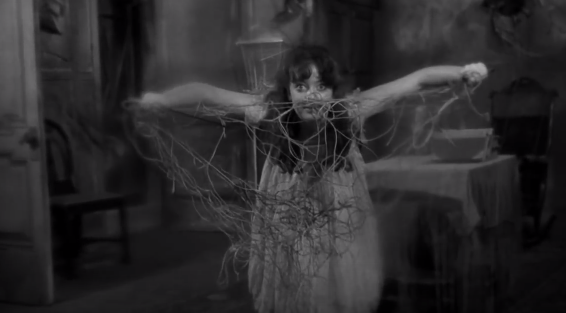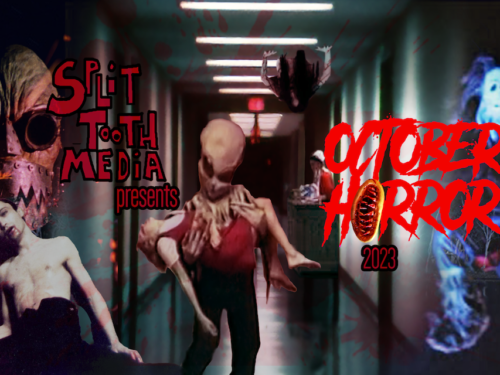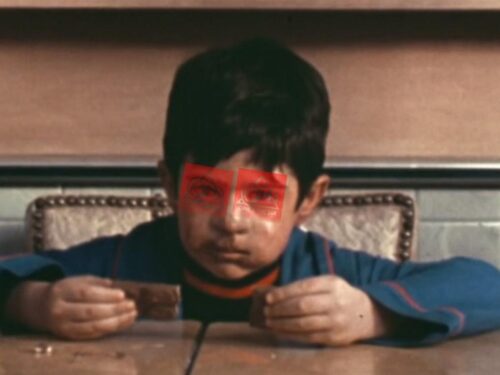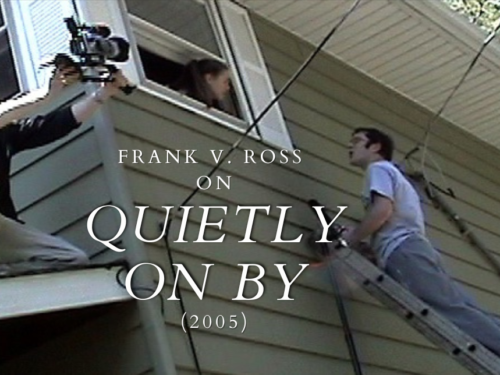“Screams and moans and bats and bones / Teenage monsters in haunted homes”
This is about a missing link. A page torn out of a book, lost under the bed. Reach underneath, push away cobwebs. You can reach it with your fingertips. If you feel something else, don’t flinch. Just let him walk over your hand. Barney startles easily.
This is about a part of the story that gets left untold. This is about Spider Baby.
The story as it is usually told, if it is told at all:
Psycho begat the slashers, Texas Chain Saw put the movie monster out to pasture, Michael Myers eclipsed Vincent Price and the American Horror Film was forever divided into Before and After, Old and New.
The eulogy for Old Horror was delivered by Boris Karloff and Peter Bogdanovich in the ’68 cheapo Corman thriller Targets. Karloff plays an aging horror star making an appearance at a drive-in theater that is turned into a real-life killing field by a sniper. The actor faces down the gunman, Old against New, Frankenstein’s Monster and Thriller TV host versus a blank-faced stand-in for Lee Harvey Oswald, Charles Whitman and whatever mass shooter was just on TV whenever you’re reading this. Old gets the drop on New, the plain suburban white boy loses his rifle and scurries away. Karloff asks no one in particular: “Is that what I was afraid of?” A double-edged line. The killer is a nobody, just a crazy kid and a coward to boot. But: the dead are still dead. The Old model is defunct. New Horror earns its crown through blood.
I borrowed the idea of Targets as eulogy from Shock Value: How a Few Eccentric Outsiders Gave Us Nightmares, Conquered Hollywood, and Invented Modern Horror, by Jason Zinoman. It is a fine book, entertaining and informative. It covers all the important names and milestones in the transition from Old to New Horror: George Romero and Night of the Living Dead, Roman Polanski and Rosemary’s Baby, Wes Craven and Last House on the Left, John Carpenter and Debra Hill and Halloween, Dan O’Bannon and the entire continent of Europe and Alien. And more. It is a fine book. If you don’t know the story, it tells it as it is usually told.
It leaves out Spider Baby.

Some people are too far outside, some nightmares too eccentric, to find a place in the usual story. Nowhere in Zinoman’s book will you find a mention of Jack Hill, or of his first feature film. And that’s OK. That’s probably how it should be. In the grand scheme of things, Spider Baby isn’t significant enough to make it into the usual telling. Shot in 1964, barely released in 1968, creeping and crawling through bootlegs and late night cable ever since, it does not exist in the conscious mind of the master narrative of Old and New Horror. It is submerged. Subterranean. But it is there. And it is alive.
If Targets is a eulogy at a funeral, Spider Baby is a howl at the wake.
Targets is Horror having already moved on from Old to New, looking back. Spider Baby is the last spasm of movement from the old body being left behind, its lurching, swinging, gyrating form both terrifying and joyful.
Spider Baby — also known at various times as Cannibal Orgy, Attack of the Liver Eaters, and The Maddest Story Ever Told — is a thing between two worlds. A sleazy cheapo done up like a classic, a psychopathic child walking around in clothes from mom and dad’s closet. Moments of genuine terror and poignancy hiding in plain sight among cartoon grotesqueries and cruel jokes.
Shot in blessed black and white in an old, dark mansion in historic Los Angeles, it spits blood and giggles the derangements of the New out of the face of the Old. (Once you’ve seen it, it feels impossible that Tobe Hooper didn’t before heading into the Texas hills with a camera and a chainsaw). Spider Baby has: A fucked-up inbred family in an old house in the hills, knife killings, mutilation, dead and sick relatives hidden in closets and basements, cannibalism, teen girls in nightgowns murdering people and the late, lamented and demented Sid Haig.
(It also has a pretty gross rape joke and a plot that hinges on developmentally disabled people being monsters. Just in case anyone is confused about what “sleazy cheapo from 1968” means.)
The movie is about the Merrye family, specifically the last three Merrye children, Virginia (Beverly Washburn), Elizabeth (Jill Banner) and Ralph (Sid Haig), and their chauffeur and caretaker, Bruno (Lon Chaney Jr.). The children are inbred and insane, suffering from “Merrye Syndrome,” a genetic condition that causes all members of the family to eventually devolve into a pre-human state. The three Merryes are older teenagers physically, but have become childlike and deranged, at once playfully innocent and cruelly bloodthirsty. Virginia, the titular “Spider Baby,” is a vision of grace and terror. She eats insects, moves like a dancer and likes to play “Spider,” which involves a net of rope, two very sharp knives and another person to play the “Bug.”
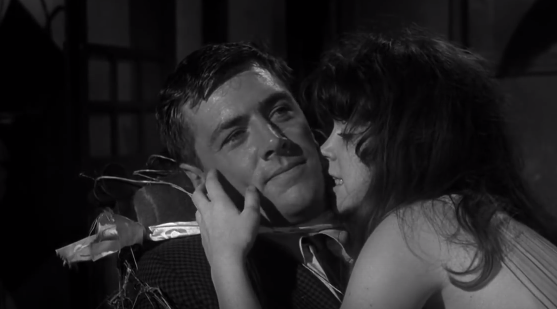
Despite Bruno’s best efforts to keep the children hidden away, the outside world bursts in when a distant relative tries to claim custody of the kids and, by extension, the property and wealth left to them by their father. Goofs and ghoulishness follow, and a good time is had by all, except the people who end up dead, which is a lot of them. Spider Baby is better than it has any right to be, better than it was even intended to be. The film does not take itself seriously, and yet the humor makes the horror more disturbing, not less. The intruders from the normal world are played broadly, comedic types winking to the audience. But Hill and his actors totally commit to the emotional reality and twisted moral logic of the Merrye family, and as the film goes along it is as if there are two movies side by side, horror and comedy, and the horror movie is invading and winning.
There is a third piece to the film, running beneath both halves, holding together what threatens to fly apart. That piece is Lon Chaney Jr.
The last great role for an actor who didn’t have a lot of great roles, whose two best roles shouldn’t have been any good at all. He was The Wolfman, of course, in 1941, and despite a beautiful fog-filled set and brilliant make-up by Jack Pierce, it is the non-werewolf scenes that make the film a classic — specifically, Chaney’s big, watery eyes and wide face twisting with fear and guilt. There has never been a greater performance of a man convinced of his own monstrousness but too weak to do anything about it.
Chaney’s performance in Spider Baby, an even unlikelier vehicle for art and truth than a werewolf movie, goes beyond his legacy-making wolf-cursed anguish. There is an honesty and depth to Chaney’s Bruno that should feel so wildly out of place as to wreck the movie, but instead it elevates the entire sordid affair. Bruno is complicit in every awful thing the Merryes do, but somehow you never doubt that this man has a fundamentally good soul. He has spent his life taking care of a family doomed to madness and violence, and from Chaney radiates the weariness, sadness and, above all, love that makes Bruno an astonishingly decent human presence in this most inhuman and indecent film.
Boris Karloff works as a symbol of the decline of Old Horror; Lon Chaney embodies it. Karloff enjoyed a late career as a beloved figure in his old age, winning a Grammy for narrating How The Grinch Stole Christmas! and licensing his image as the grand old man of horror. Lon Chaney Jr. had a long career of small parts and diminished returns. He ended his life as he lived a lot of it — mostly forgotten and usually drunk.
In the grand narrative, Boris Karloff is the right choice. He’s the right symbol. That’s how the story probably should be told.
But some time, some night, another version might flicker onto your TV set. Somewhere under the bed that torn page is gathering dust. Somewhere, someone is stringing film onto a projector at midnight. The lights go down, the projector clacks to life, and the maddest story ever told starts dancing across the screen.
And Lon Chaney Jr. sings the theme song.
Stream Spider Baby here
Follow Jason and Split Tooth Media on Twitter
Find the complete October Horror Archive here:

Follow our list of the 31 Days of October Horror on Letterboxd
(Split Tooth may earn a commission from purchases made through affiliate links on our site.

